The customer of this 3-4t/h floating fish feed mill project is the first time to contact the aquatic feed processing industry. Due to sufficient funds, he invested in a new 3-4t/h aquatic extruded feed production project, rented idle workshops for production and operation, and the land use is industrial land. The plant area of the project is 2,600 m², and there are production workshops and storage areas in the plant area.
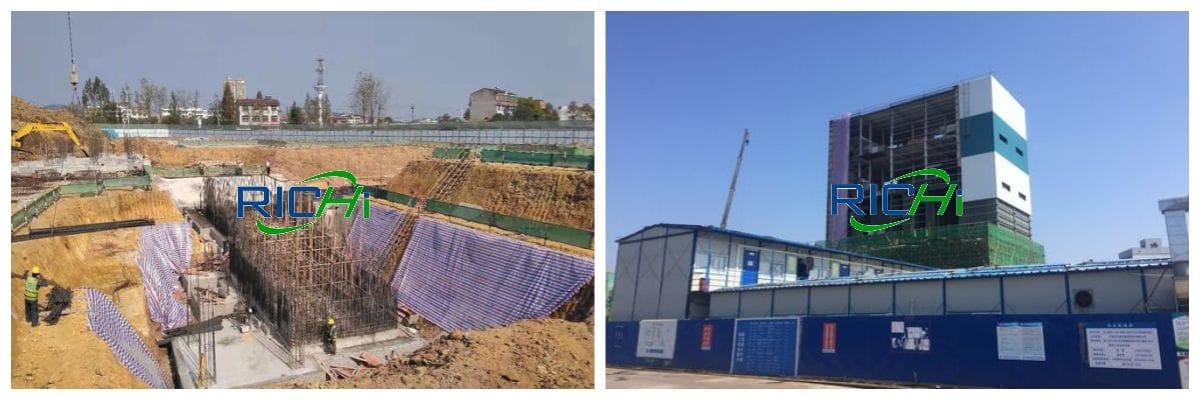
- Nature of construction: newly built
- Production scale: 8,000 tons of aquatic feed per year
- Total investment: The total investment of the project is 600,000 US dollars
- Number of employees: 11
- Working system: One shift of 8 hours is implemented, and the annual working days are estimated to be about 300 days
- Floating fish feed manufacturing process design: batching-crushing-mixing-superfine pulverization-mixing-expansion-drying-cooling-packaging
With the sustained and healthy growth of the economy, the continuous improvement of people’s living standards, and the gradual improvement of the dietary structure, people’s demand for aquatic products is increasing year by year, and the demand for aquatic products with good quality and high price is also increasing.
On the whole, there is a large room for future growth in the market demand for aquatic products, which provides a good development environment for the aquaculture and aquatic feed industries. (Related solution: 4-5T/H fish feed pellet production line)
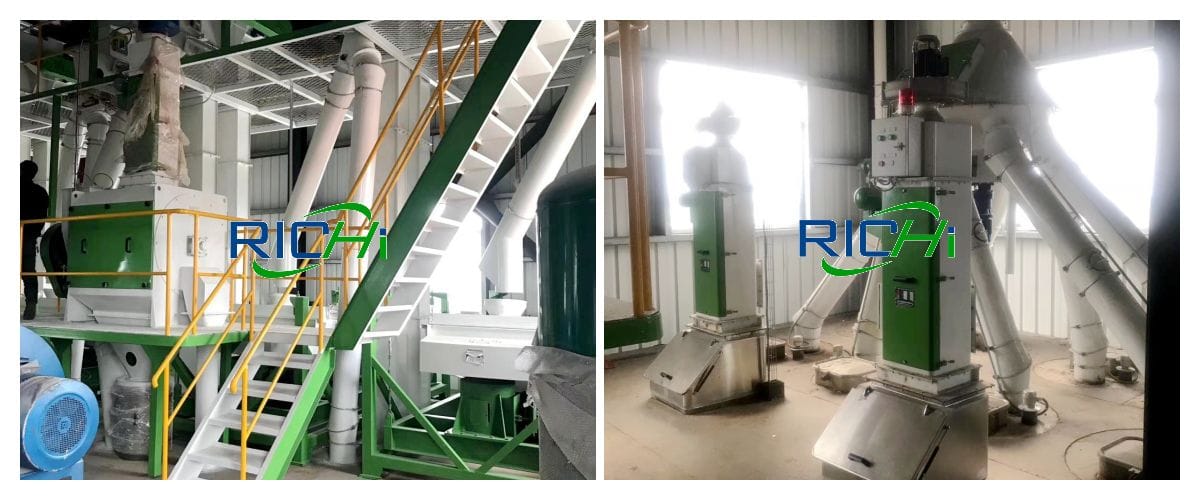
Benefiting from the rapid development of the aquaculture industry and the continuous increase in the penetration rate of aquafeed, the global aquafeed industry has also achieved vigorous development, and the market demand for aquafeed continues to increase. Because of seeing such a prospect, the client believes that investing in the field of aquatic feed processing can bring good returns.
Main engineering and product plan of 3-4 t/h floating fish feed mill
| Engineering name | Product name | Design ability | Annual run hours |
|---|---|---|---|
| Production workshop | Aquafeed | 8000 tons/year | 2400 hours |
Other construction:
- Raw material warehouse: one month raw material storage capacity, 200 m²;
- Finished product warehouse: 200 m² of raw material storage per month.
Main raw material consumption
| Name | Annual Usage |
|---|---|
| Rape meal | 2000 tons |
| Fish meal | 500 tons |
| Peanut Meal | 1600 tons |
| Soybean meal | 1600 tons |
| Flour | 1800 tons |
Main equipment for 3-4 t/h floating fish feed mill
| Name | QTY |
|---|---|
| Fish feed pellet cooling machine | 1 |
| Fish feed dryer machine | 1 |
| Floating fish feed extruder machine | 2 |
| Fish feed mixer | 2 |
| Fish feed grinding machine | 3 |
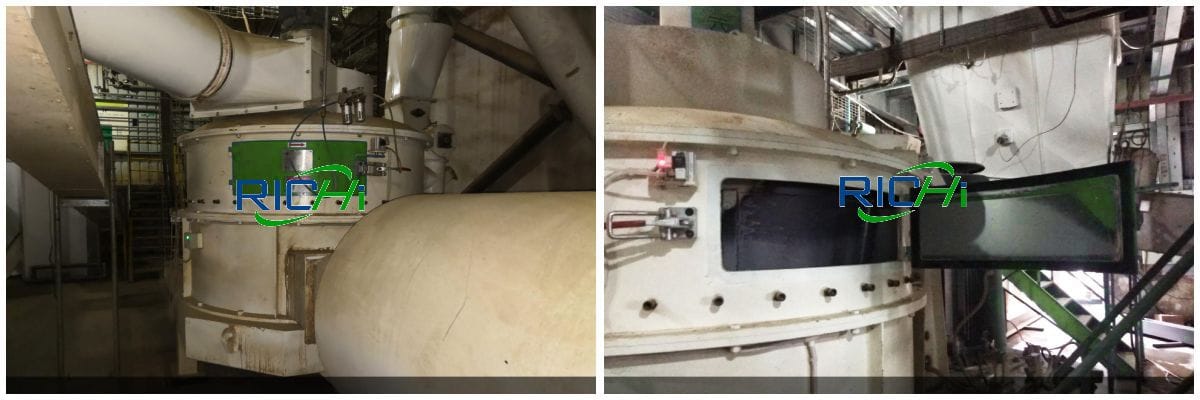
Energy consumption of 3-4 t/h floating fish feed mill
| Name | Annual Consumption |
|---|---|
| Water (tons/year) | 630 |
| Electricity (kwh/a) | 120,000 |
3-4T/H floating fish feed plant process design
The characteristics of extruded fish feed are small crushing fineness (about 60-100 mesh), high degree of ripening, high oil content (the oiling method is a combination of mixer, extruder, and coating), and the diameter of the finished product is large ( about 0.6-20mm).
The production capacity of this extruded floating fish feed production plant is designed to be 3-4 tons per hour, adopting primary crushing process, primary batching and mixing process, primary crushing system, secondary mixing process, extrusion process, coating, cooling, screening and bagging process.
The total power of this floating fish feed line is about 450kw, the operating area is about 30*24*30m, and it is equipped with a 1-ton boiler of 3-4tph extrusion aquatic fish feed factory. The RICHI design of the whole plant layout is customized according to customer requirements, the structure is compact and treasonable, so it meets the requirements of environmental protection.
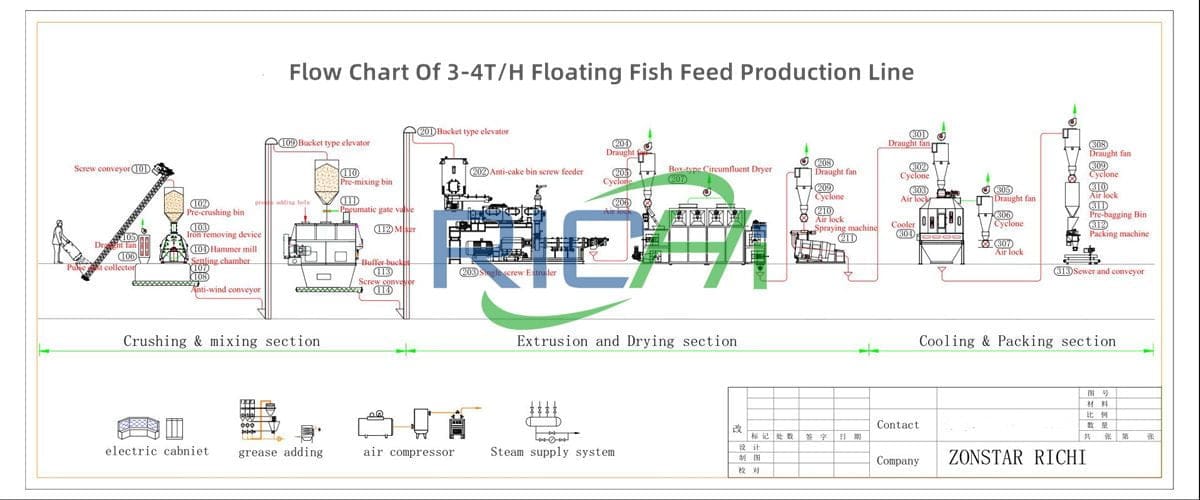
- Ingredient: mix raw materials such as rapeseed meal, fish meal, peanut meal, soybean meal and flour according to different proportions.
- Crushing: Put the ingredients into the grinder to crush the raw materials initially.
- Mixing: The primary pulverized raw materials are mixed in the mixer through the sealed conveyor belt.
- Superfine crushing: The raw materials are sent to the pulverizer through the sealed conveyor belt, and the mixed raw materials are further pulverized. The material is crushed at high speed by the pulverizer. (Hot products: floating fish feed machine)
- Mixing: The raw materials are mixed in the mixer through the sealed conveyor belt.
- Puffing granulation: The material from the mixing section is heated to 85°C for gelatinization by high-temperature steam. This 3-4t/h floating fish feed mill process produces a full-structure matrix in the puffed granules containing soluble sugar and fiber, which increases the volume of the granules and becomes a porous structure. , can absorb more fat. Then use the twin-screw extruder to make the batch into the required granules.
- Drying: The moisture content of the extruded pellets is higher than the moisture content specified in the product specification, so it needs to be dried by a fish feed dryer. The aqua feed dryer volatilizes excess moisture in the material through electric heating, and finally makes the moisture content of the product reach the specified standard.
- Cooling: The finished pellets enter the counter-flow cooler for cooling, the feed temperature is reduced from 50-60℃ to normal temperature, and the cooled pellets are sent to the finished product warehouse through the conveyor and hoist.
- Packaging: An electronic packing scale is installed under the finished product warehouse. The packing scale automatically packs quantitatively according to the adjusted and set amount, and then the bag is sewn by the bag sewing machine, and is automatically transported to the stacking car to complete the production process.

Note:
- A certain amount of cooling waste water will be produced during the cooling process of this project. The amount of cooling wastewater produced is about 300m³/a. After the sedimentation treatment in the sedimentation tank, the clear water is reused and not discharged; the sediment is cleaned regularly and reused by the manufacturer.
- The 3-4t/h floating fish feed mill project produces dust particles in the process of crushing, mixing, drying, and cooling. After checking with the owner, the amount of particles produced is 122.1t/a. The crushing, mixing, drying, and cooling sections are all closed operations. After being treated by a bag filter device, it is discharged through a 15m high exhaust pipe.
- Use low-noise and low-vibration equipment when selecting equipment; rationally layout the workshop, pay attention to keeping a sufficient distance between the noisy workshop and the factory boundary in the general layout, and make the walls of the room sound-absorbing and sound-insulating. (Related solution: 4T/H aqua feed mill)
Clean production
The production of this floating fish feed plant project reduces the amount of materials, resources and energy as much as possible, uses clean energy, and the raw materials are non-toxic, and the waste is treated and disposed of as a resource and harmless, effectively reducing the generation of industrial solid waste. The equipment we configure for customers reaches the industry’s advanced level level, in line with the requirements of cleaner production.
The prospect of extruded feed
In some countries, over the years, farmers have been obsessed with the price of feed. It has become a consensus among them to choose feed that “the fish price is better to use extruded feed, and the fish price difference is to use pellet feed”.
However, as consumers’ calls for “green food” are getting higher and higher, the current aquaculture industry is gradually developing from a quantitative type to a quality type. At present, most places have formed a new mode of processing and breeding with extruded feed as the mainstream.
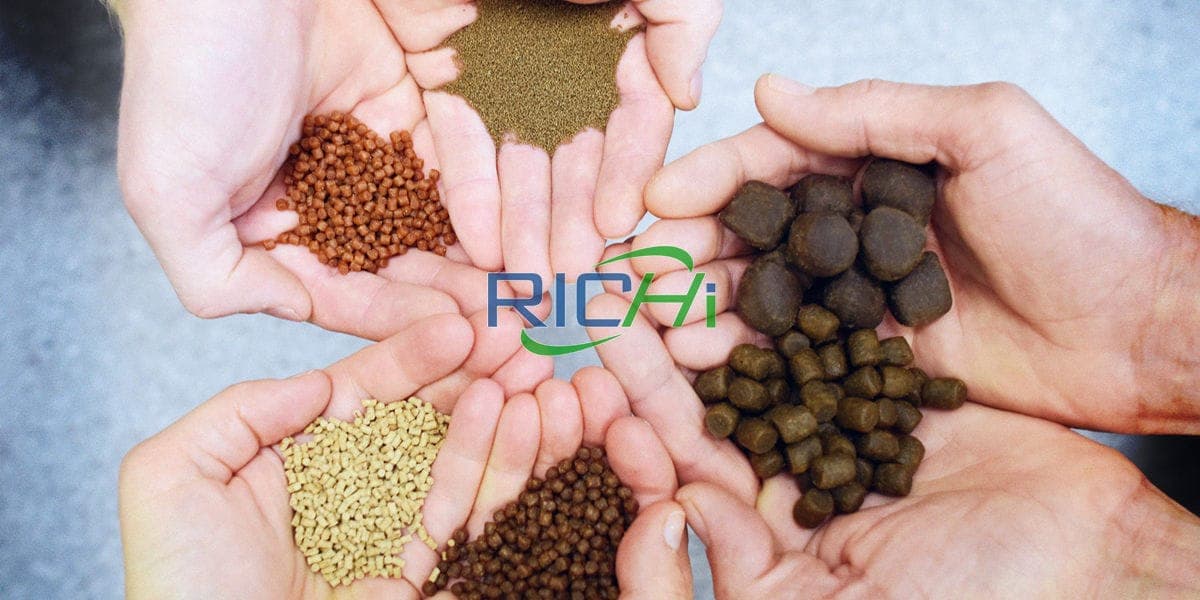
The use of extrusion technology to produce extruded feed has become the development trend of aquatic feed processing technology. The unique function of the fish feed extruder is to change the weight of the feed to make the extruded fish feed float, slowly sink and sink. Floating fish feed can not only improve feed efficiency, but more importantly, farmers can see the feeding situation of fish, which can avoid overfeeding and reduce feed waste.
If you are also interested in building a 3-4t/h floating fish feed mill, please feel free to contact Richi Machinery.